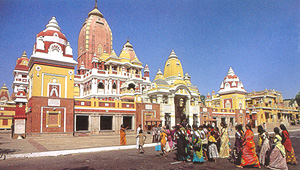
Temples
In India there are many temples dedicated to Lord Vishnu in his various forms, such as Govinda, Madnusudliana, Narasimha, Madnava, Kesava, Narayana, Padmanabha, Parthasarathi, and many others. The Lord expands Himself into innumerable forms, but all of them are not different from one another. Lord Vishnu has four hands, and each hand holds a particular item-conch shell, wheel, club, and lotus flower.
Of these four emblems, the caicra, or wheel, is the chief. Lord Krishna, being the original Vishnu form, has only one emblem, namely the wheel, and therefore He is sometimes called Caleri. The Lord's cakra is the symbol of the power by which the Lord controls the whole manifestation. The spires of Vishnu temples are marked with the symbol of the wheel so that people may have the chance to see this symbol from a very long distance and at once remember Krishna.
The purpose of building very high temples is to give people a chance to see them from a distant place. This system is carried on in India whenever a new temple is constructed, and it appears that it is coming down from a time before recorded history.
The Deities can be moving (dhruvabera) or unmoving (cala). The unmoving ones are usually big and made of stone. The moving images are made of metal such as bronze or an alloy of five metals (pancaloha). The moving Deity is taken out on festive occasions and is used for bathing, ritualistic worship.
A third type of Deity is calacala (both movable and immovable. This would be the case with Lord Jaganatha in Puri who goes out once a year for a chariot ride (Ratha-yatra) Temple worship usually consists of bathing the Deity in the morning, offering food stuffs, dressing, arati, processions and festivals. The priests who worship the Lord in the temple are called pujaris.
|